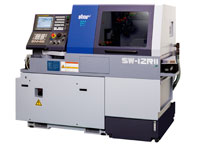Swiss Type Automatic Lathe SW-12R II to be Newly Released
A Small-Diameter Machining Model Added to the SW Series in Pursuit of the World Highest Speed and Productivity
Features of SW-12R II
High productivity
- The opposing gang-type tool posts are independently controlled to carry out simultaneous machining with reduced machining time.
- The 8-spindle unit with a Y-axis control function designed for rear-end machining can divide the process efficiently on the front and rear sides.
- The Star Motion Control System reduces the non-cutting time.
High functionality
- The gang-type tool post can accommodate a variety of tool units for enhanced complex machining capabilities.
- The guide bush and non-guide bush types can be switched over depending on the total workpiece length to realize the most appropriate machining.
- The 8-spindle unit with a Y-axis control function especially designed for rear-end machining improves the rear-end complex machining capabilities.
High accuracy
- The built-in type main and sub spindles achieve improved indexing accuracy.
- The Star Motion Control System controls machine vibration and achieves smooth spindle movement.
Major Specifications
| Max. machining diameter | ø13mm | ||
|---|---|---|---|
| Max. headstock stroke | Guide bush type | 135mm | |
| Non-guide bush type | 30mm | ||
| Max. main spindle speed | 15000 min-1 | ||
| Main spindle motor | 2.2kw / 3.7kw (built-in motor) | ||
| Max. sub spindle speed | 15000 min-1 | ||
| Sub spindle motor | 2.2kw / 3.7kw (built-in motor) | ||
| Max. power tool rotation speed | 12000 min-1 | ||
| Power tool motor | 1.0kw / 1.2kw | ||
| Front-end machining capability | Stationary tool | Max. drilling capability | ø8mm |
| Max. cutting tapping capability | M8 x P1.25 | ||
| Power tool | Max. drilling capability | ø5mm | |
| Max. cutting tapping capability | M4 x P0.7 | ||
| Rear-end machining capability | Stationary tool | Max. drilling capability | ø8mm |
| Max. cutting tapping capability | M6 x P1.0 | ||
| Power tool | Max. drilling capability | ø5mm | |
| Max. cutting tapping capability | M4 x P0.7 | ||
| Machine dimensions (W x D x H) | 995 x 920 x 1700 mm | ||
NOTE 1: Swiss-type automatic lathe
The Swiss-type automatic lathe was devised as watch component processing machinery in Switzerland in 1870s. Known as a “sliding head-type automatic lathe” as well, it has remarkable characteristics of high-precision cutting of components with longer length compared with the diameter.
In general, if long and narrow parts are processed with a general-purpose lathe, flexure will occur on the workpiece, making finishing with the correct dimensions impossible. The Swiss-type automatic lathe utilizes a guide bush to function as a material steady rest. The tool, positioned at a certain distance from the guide bush, gives a cutting motion only the direction of outside diameter. This allows the workpiece to be cut accurately with no flexure. As for axial motion, the headstock, rather than the tailstock, moves while clamping a workpiece.
NOTE 2: Star Motion Control System
General machining, when NC-controlled, is composed of the following processes:
[Tool selection] → [Approach] → [Cutting] → [Disengagement] → [Next tool selection] → [Approach] → [Next cutting]
In this process, functions other than actual cutting largely affect the machining time. The Star Motion Control System is a function to reduce this non-cutting time.
The Star Motion Control data can be created easily by NC program conversion through “optimization”.
This “optimization” finishes processing related the switching of control systems and completes the processes of [Tool selection] and [Approach] during the process of [Cutting], and the [Disengagement] process of the tool and the next [Cutting] process are controlled to start at the same time. By this control method, the time required for the processes of [Disengagement], [Next tool selection] and [Approach] can be minimized to reduce the non-cutting time.
NOTE 3: Non-Guide Bush Type
This is a sliding head-type automatic lathe which is designed based on the Swiss-type automatic lathe with a guide bush dismounted. Without a guide bush, it is not best suited for machining narrow and long parts. If the workpiece is short and does not deflect without using a guide bush, however, such a material can be handled effectively.
With the Swiss-type automatic lathe, the rear side of the bar material needs to be handled as waste as a portion equivalent to the size of the guide bush structure which functions as a material steady rest cannot be machined. The non-guide bush type reduces the wastes from materials to about 1/3 in length compared to the waste made by the guide bush type.

